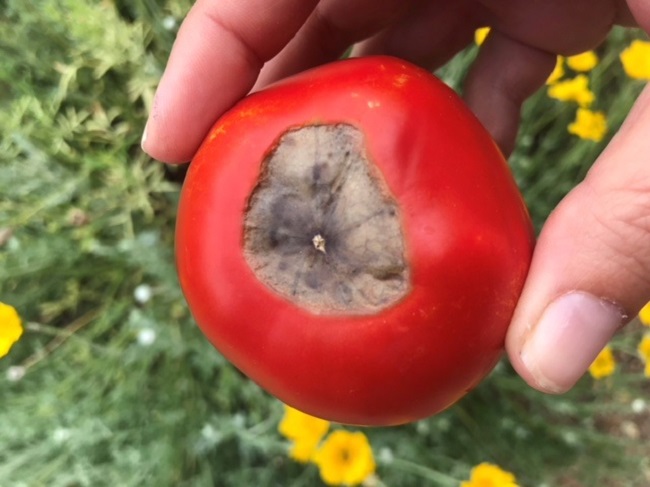 Blossom end rot on a tomato picked at the NMSU Agricultural Science Center at Los Lunas on August 21 (photo credit M. Thompson).This week, when trying to select a question for the column, I looked through the 22-year archive for this gardening column online (http://aces.nmsu.edu/ces/yard/archives/) to find issues that pop up again and again at this time of year. I selected these three columns written in 1996, 1997, and 2000 by my predecessor, Dr. Curtis Smith, retired NMSU Extension Horticulture Specialist.
Blossom end rot on a tomato picked at the NMSU Agricultural Science Center at Los Lunas on August 21 (photo credit M. Thompson).This week, when trying to select a question for the column, I looked through the 22-year archive for this gardening column online (http://aces.nmsu.edu/ces/yard/archives/) to find issues that pop up again and again at this time of year. I selected these three columns written in 1996, 1997, and 2000 by my predecessor, Dr. Curtis Smith, retired NMSU Extension Horticulture Specialist.
Question: My watermelon crop had at least a dozen blooms and good-sized melons, but then died due to "brown rot" on the bottom of each melon (not the part that touches the ground, but the end of the fruit). What is causing this and what can we do to prevent the remaining melons from dying before they are fully mature?
Answer: You have described the symptoms of blossom end rot. This malady can affect watermelons as well as cucumbers, tomatoes, chiles, squash, and many other fruits produced in the garden. Blossom end rot is due to a calcium deficiency in the developing fruit. The deficiency can be due to a lack of calcium in the soil, as is the case in parts of the country with acid soil. In the Southwest, with our alkaline soils and superabundance of calcium, it would seem that blossom end rot would be impossible. However, if water, which transports calcium and other minerals, doesn't reach the end of the fruit during the critical time when the fruit is developing, blossom end rot will develop. The failure of water to reach the fruit can be due to inconsistent watering during fruit development or, in the case of too much water, the absence of adequate oxygen around the roots that prevents the absorption of water and minerals.
Question: Can I prune my junipers now?
Answer: You may prune junipers now, but if the junipers are pruned extensively, winter damage may follow late pruning. The junipers will also not be able to cover any unsightly spots exposed by pruning now since they will not grow in the autumn and winter. If a few branches are interfering with traffic or your management of other plants, go ahead and prune the offending branches. Save the major pruning for spring.
Question: All of a sudden, I have gray bugs with black legs on my squash plants. They weren't there yesterday, now they are everywhere. What are they and are they harmful?
Answer: You have the infamous squash bug. They do seem to suddenly appear out of thin air. They are very debilitating to squash plants and may carry plant diseases, which compounds their damaging effects.
They are difficult to control. Mechanical control by physically removing and killing them is one method. Also, look for their masses of shiny brown eggs on the underside of the lower leaves. Smash the eggs when you find them. Some insecticides labeled for squash bugs are effective when the bugs are very young. As the bugs get older, the insecticides become much less effective, and mechanical control becomes the preferred method. If you use insecticides, follow the directions on the label carefully to maximize their effectiveness and safety.
Some people delay planting squash until July to avoid the squash bug. Dr. Charles Ward, [retired] NMSU Extension Entomologist, warns that delayed planting will not always be successful. In my garden, he was correct this year. I planted late and still suffered a squash bug attack. Now every morning I must go on bug patrol, rubbing them out (literally) when I find them. Good luck!
For a video on controlling squash bugs in NM, photos of blossom end rot, and more pruning tips, visit https://nmsudesertblooms.blogspot.com/.
Send gardening questions to Southwest Yard and Garden - Attn: Dr. Marisa Thompson at desertblooms@nmsu.edu, or at the NM Desert Blooms Facebook page (@NMDesertBlooms)
Please copy your County Extension Agent (http://aces.nmsu.edu/county/) and indicate your county of residence when you submit your question!
For more gardening information, visit the NMSU Extension Horticulture page at Desert Blooms (http://desertblooms.nmsu.edu/) and the NMSU Horticulture Publications page at http://aces.nmsu.edu/pubs/_h/.
Marisa Y. Thompson, Ph.D., is the Extension Horticulture Specialist, in the Department of Extension Plant Sciences at the New Mexico State University Los Lunas Agricultural Science Center, office: 505- 865-7340, ext. 113.